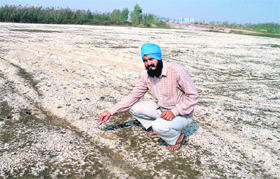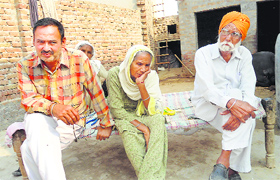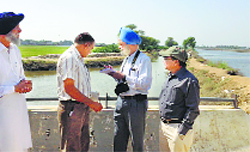AGRICULTURE
Muktsar’s harvest: Water, salt & grief
Listed as ‘crown wasteland’ in British records and later as the ‘food bowl’, Muktsar in southwestern Punjab suffers from severe waterlogging. Land across many hectares has been rendered unproductive. The government has constructed drains, installed pumps, laid pipes, but the situation remains the same. What is it doing wrong?
By Archit Watts
 GOLD  TO DUST: Hardyal Singh, a farmer, on his land that has turned saline at Kattianwali village in Muktsar district. Waterlogging causes salinisation of land. Tribune photos: Archit Watts TO DUST: Hardyal Singh, a farmer, on his land that has turned saline at Kattianwali village in Muktsar district. Waterlogging causes salinisation of land. Tribune photos: Archit Watts |
OVER the years, cropping pattern in Muktsar has changed from wheat-cotton to wheat-paddy and wheat-basmati rotation due to waterlogging. Hence, other cash crops like sugarcane, mustard and cereals have got eliminated. Now, the cropping pattern is again changing as a large number of farmers have opted for fisheries.
This area was once the prime cotton belt because of “tibbas” (sand dunes). Canal irrigation, land development, levelling and other infrastructure revolutionised the cultivation of cash crops like cotton and basmati. However, the area is now fast turning into a wetland, with even migratory birds arriving here almost every year as the fields remain inundated for long.
Dr JS Samra, CEO, National Rainfed Area Authority, Planning Commission of India, says in his report: “Canal water allowance was very high and vertical drainage—like in other parts of Punjab by privately INVESTED tube-wells—was not feasible due to high concentration of salts and unfit ground water aquifer for irrigation. Indigenously unfit, poor quality ground water came up by about 40 m in 50 years and is now within 2 m below ground (waterlogged) due to seepage from canals, distributaries, inefficiency of flood irrigation and unprecedented expansion of cultivation of rice.”
tube-wells—was not feasible due to high concentration of salts and unfit ground water aquifer for irrigation. Indigenously unfit, poor quality ground water came up by about 40 m in 50 years and is now within 2 m below ground (waterlogged) due to seepage from canals, distributaries, inefficiency of flood irrigation and unprecedented expansion of cultivation of rice.”
 tube-wells—was not feasible due to high concentration of salts and unfit ground water aquifer for irrigation. Indigenously unfit, poor quality ground water came up by about 40 m in 50 years and is now within 2 m below ground (waterlogged) due to seepage from canals, distributaries, inefficiency of flood irrigation and unprecedented expansion of cultivation of rice.”
tube-wells—was not feasible due to high concentration of salts and unfit ground water aquifer for irrigation. Indigenously unfit, poor quality ground water came up by about 40 m in 50 years and is now within 2 m below ground (waterlogged) due to seepage from canals, distributaries, inefficiency of flood irrigation and unprecedented expansion of cultivation of rice.” Avtar Kaur along with her son and brother-in-law at Ghagga village of Muktsar district. They are struggling to repay their huge debt. |
New drains proposed, but no work yet
Despite the recommendations of BS Dhaliwal, technical adviser to the Chief Minister, to construct new drains and widen existing drains taking 0.5-m interval contours, nothing has been done so far. Nearly 12 drains were proposed to be built in Muktsar and Fazilka districts last year.
The 0.5-m contour level sheet is required for the smooth flow of water in drains.
Gurdev Singh, Chief Engineer, Drainage, says: “Though some new drains have to be constructed, no work—apart from Shajrana drain in Fazilka district—was carried out over the past one year. New drains have to be designed taking 0.5-m interval contours, which is not available. The department had approached the SURVEY of India last year, but it had sought one-and-a-half-years to do the job. The project report has been submitted to the Chief Minister.”
of India last year, but it had sought one-and-a-half-years to do the job. The project report has been submitted to the Chief Minister.”
 of India last year, but it had sought one-and-a-half-years to do the job. The project report has been submitted to the Chief Minister.”
of India last year, but it had sought one-and-a-half-years to do the job. The project report has been submitted to the Chief Minister.”
Farmers to labourers
Master Jeevan Singh and his three brothers (all in their 70s) used to earn huge profit from their 28-acre fertile land in the 1990s, growing wheat, mustard and cotton. But their life changed when their land started turning wet and was rendered unfit for farming. The second generation in their family is now working as a tailor and an electrician.
“We got nominal compensation against our land. We had to get our third daughter married when waterlogging ruined our land. My husband was a government teacher and we had to borrow MONEY from relatives, which we have not been able to repay even now. Our debt only increased as we had to marry off more daughters and a son,” says Avtar Kaur, wife of Master Jeevan Singh.
from relatives, which we have not been able to repay even now. Our debt only increased as we had to marry off more daughters and a son,” says Avtar Kaur, wife of Master Jeevan Singh.
 from relatives, which we have not been able to repay even now. Our debt only increased as we had to marry off more daughters and a son,” says Avtar Kaur, wife of Master Jeevan Singh.
from relatives, which we have not been able to repay even now. Our debt only increased as we had to marry off more daughters and a son,” says Avtar Kaur, wife of Master Jeevan Singh.
Similarly, sons of his brothers Amarjit Singh, Surjit Singh and Malkit Singh are doing small jobs. Amarjit Singh says: “We used to harvest a bumper cotton crop, as also peanuts, mustard and paddy. But now we have to buy wheat for domestic use.”
As per the report of Dr Mihir Shah, a member, Water Resources and Rural development, Planning Commission of India, over 2 lakh farmers in Punjab have lost their primary source of income from agriculture as their lands have become unproductive. Some farmers are now forced to work as labourers.
Puran Singh Doda, district president of the Bharti Kisan Union (Ekta Ugrahan), says: “As per a recent SURVEY conducted by our teams in 131 villages of the district, 539 farmers committed suicide due to crop failure and increasing debts since 1990. Various factors like poor quality pesticides and seeds, besides waterlogging are responsible for crop failure.”
conducted by our teams in 131 villages of the district, 539 farmers committed suicide due to crop failure and increasing debts since 1990. Various factors like poor quality pesticides and seeds, besides waterlogging are responsible for crop failure.”
 conducted by our teams in 131 villages of the district, 539 farmers committed suicide due to crop failure and increasing debts since 1990. Various factors like poor quality pesticides and seeds, besides waterlogging are responsible for crop failure.”
conducted by our teams in 131 villages of the district, 539 farmers committed suicide due to crop failure and increasing debts since 1990. Various factors like poor quality pesticides and seeds, besides waterlogging are responsible for crop failure.”
No wedding bells here
Many men and women aged between 18 and 40 are still unmarried in waterlogged villages. At Rattakhera village, falling in Chief Minister Parkash Singh Badal’s Lambi Assembly segment—reportedly being developed as a model village—a large number of people are unmarried.
The land in this village was allotted to those who migrated from Ghavind village in Pakistan. The first generation in the village says earlier they faced difficulties in getting married as no one from the region accepted them. Now, they are facing a similar situation due to waterlogging.
Living in a kutcha house, Charan Singh, who owns 5 acres of infertile land, and father of two sons, says: “We had 20 acres in Pakistan. When we came here, we were allotted 5 acres, which has been rendered infertile. We just have four buffaloes now. Nobody is willing to give their daughter’s hand to my son in marriage. He is 40 years old.” A senior official in the district administration says as per a recent socio-economic SURVEY conducted at Rattakhera village, nearly 18 per cent men and 15 per cent women were unmarried.
conducted at Rattakhera village, nearly 18 per cent men and 15 per cent women were unmarried.
 conducted at Rattakhera village, nearly 18 per cent men and 15 per cent women were unmarried.
conducted at Rattakhera village, nearly 18 per cent men and 15 per cent women were unmarried.
Abohar, Fazilka at risk
As witnessed last year and this year too, the problem of waterlogging is spreading to Abohar and Fazilka areas. The water in drains meant to prevent waterlogging in Muktsar villages has overflowed to Fazilka district.
Flood waters in the Aspal drain inundated paddy and cotton crops on 26,638 hectares in Fazilka district this year. The drain originates from Aspal village in Lambi and passes through a dozen villages of Muktsar and Fazilka districts. As heavy rains lashed the area this year, the drain began to overflow and flooded villages in Fazilka district. Further, the flow of underground water is also responsible for this. In such a situation, the government must act speedily to contain the loss.
What is waterlogging
Soil is waterlogged when the water table is too high to permit an anticipated activity like agriculture. During rains, the losses increase as rainwater inundates fields, causing damage to crops and buildings.
State of land in punjab
Land affected in state: 2 lakh hectares
Land affected in Muktsar district: 1.05 lakh hectares
Other affected districts: Fazilka, Faridkot, Ferozepur, Mansa and Gurdaspur
(as per a report tabled in vidhan sabha by chief minister parkash singh badal in 2013)
(as per a report tabled in vidhan sabha by chief minister parkash singh badal in 2013)
MONEY spent to check waterlogging in Muktsar: ~1,100 cr
spent to check waterlogging in Muktsar: ~1,100 cr
 spent to check waterlogging in Muktsar: ~1,100 cr
spent to check waterlogging in Muktsar: ~1,100 cr
STOCK taking
taking
 taking
taking The Planning Commission team at Midda in 2012. |
In 2012, then Union Minister for Rural Development Jai Ram Ramesh visited the state and sent a team of experts under Dr Mihir Shah, a member, Water Resources and Rural development, Planning Commission of India, to take STOCK . The state forwarded a Rs 960-crore project to the Planning Commission. The first instalment of Rs 50 crore was paid to Punjab in January this year. The second instalment of Rs 190 crore is in the pipeline.
. The state forwarded a Rs 960-crore project to the Planning Commission. The first instalment of Rs 50 crore was paid to Punjab in January this year. The second instalment of Rs 190 crore is in the pipeline.
 . The state forwarded a Rs 960-crore project to the Planning Commission. The first instalment of Rs 50 crore was paid to Punjab in January this year. The second instalment of Rs 190 crore is in the pipeline.
. The state forwarded a Rs 960-crore project to the Planning Commission. The first instalment of Rs 50 crore was paid to Punjab in January this year. The second instalment of Rs 190 crore is in the pipeline.
Major causes of waterlogging
- Seepage of 700 cusecs from Rajasthan feeder canal and 300 cusecs from Sirhind feeder canal.
- Shallow tube-wells installed to check seepage not working due poor upkeep.
- Widening of drains not as per new design.
- Alarming rise of water table .
- Less use of ground water for irrigation.
- Alignment of drains changed plan due to administrative, political influence.
- Obstruction in flow of water in drains and blockade in ditch channels.
- Oversized lateral, link drains that lead to early filling of main drains.
Solutions by high-level expert group in 2013
- Relining of Rajasthan and Sirhind feeder canals to check seepage.
- Construction of new surface drains; widening of existing drains.
- Construction of ‘bundhs’ to avoid flooding of adjoining arable land.
- More network of sub-surface drainage system.
- Diversification to crops requiring low water.
- Dairy development; focus on fisheries
- Development of bio drainage and micro-irrigation system with solar energy.
‘Put contour plan in place’
The state government must carry out a water balance study of Muktsar and make it public. The 1997 World Bank-approved Rs 464-crore project report for Faridkot should be updated and a new project should be made. The opinion of experts should be taken in finding the right solution. The Chandbhan drain should be designed on engineering guidelines. The construction of surface drains is held up for want of a contour interval plan. If 0.5-m interval contours are not available, GPS technology can be used for carving out new drains. It may take up to two years for the contour plan to be made available. Till then the impact of the rising water level will continue. Crop diversification should be promoted and diversified crops must have MSP
—Dr GS Dhillon, a water management consultant
Sub-surface drainage system of no help
 A labourer at an inundated cotton field in Muktsar.  A tube-well installed under Nabard project at Pakki Tibbi village is not functioning. |
THE state government has planned to create more network of sub-surface drainage system, but in a majority of areas, such a drainage system has ceased to work. At Pakki Tibbi village on the Malout-Abohar national highway, and native village of Dr Mangal Singh Sandhu, state Director Agriculture, tube-wells installed to lift water from sub-surface channels are not functioning.
Harpal Singh, a farmer, says: “Six-seven years ago, the drainage department had laid a network of sub-surface drains in our 8-acre waterlogged land. Nearly 300 acres in the village was brought under this scheme and five tube-wells were installed. But these tube-wells rarely work. We are still unable to grow any other crop on our land except paddy. The yield is also low.”
“The design of the existing drainage was found faulty by a team of experts that visited the village in 2013. But influential jathedars of the SAD did not allow officials concerned to alter its design. As a result, our village remains flooded during the rains,” he claims. Gulshan Nagpal, executive engineer (drainage department), Faridkot division at Gidderbaha, however, claims that the results of the sub-surface drainage system were positive at Tappakhera, Mann and other villages.
Bio-drainage project not popular
 For Jasvir Singh, eucalyptus trees didn’t work. |
The bio-drainage project to tackle waterlogging by planting eucalyptus trees has got mixed results. While in some parts, the trees have grown, in some pockets these have dried. At Rattakhera village, Jasvir Singh, a farmer on whose 3 acres the forest department had planted 2,800 eucalyptus trees last year, says: “Almost 90 per cent of the trees have failed to grow. Apart from wild growth, nothing can be seen on my land. When experts visit the village, I ask them to level my field so I can at least grow fodder.” Jasvir Singh owns 13 acres, of which nine are waterlogged. Similarly, Joginder Singh of Tappakhera village says: “The forest department planted eucalyptus trees across 3 acres of my land last year. They grew to 10 ft, but 70 per cent of them fell due to flooding in September.” However, at Fatehpur Manian village, the trees have grown successfully.
Fish ponds no better
 Fish ponds were flooded during September rains. |
Despite government claims about ample scope of aquaculture, fish ponds have also been affected. At Ghagga, fish ponds were damaged during September rains. “We have 16 acres but are unable to cultivate 12 acres. We have a debt of Rs 12 lakh. We set up a fish pond as the government had provided 90 per cent subsidy. However, during rains, water got accumulated and damaged the pond. Some ponds were washed away,” says Jasvir Singh, a farmer. “The government had announced a thermal plant after acquiring waterlogged land of Ghagga Thehri and Babania, but it’s been scrapped, he says. However, Ramesh Kumar, Assistant Director, Fisheries, Muktsar, claims: “Fish ponds have been set up in nearly 722 acres of private land. It has good scope. Some progressive farmers have been trained in prawn farming. Some farmers have produced 6 tonne fish from a one-hectare pond.”
Courtesy: The Tribune (www.tribuneindia.com)